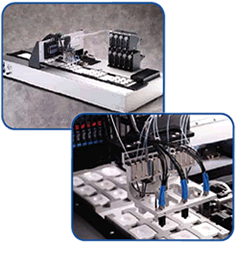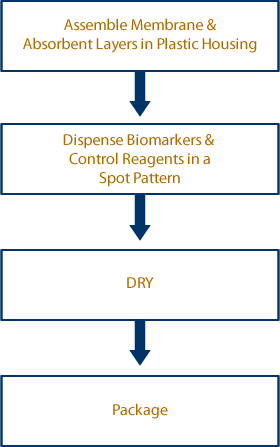 2852 Alton Pkwy, Irvine, CA 92606
2852 Alton Pkwy, Irvine, CA 92606
INTRODUCTION
 Flow Through and Lateral Flow diagnostic devices both use membranes as the active media on which the relative biomarkers are printed and the assay is executed.
In the Flowthrough device the reagents and sample flow normal to the
membrane while in the Lateral Flow device they flow parallel and within the
membrane. Both employ an absorbing pad where in Flow through it sits under
the membrane and for Lateral Flow it sits at the end of the membrane flow
path. Hence the assembly and development methods are somewhat different.
Flow Through and Lateral Flow diagnostic devices both use membranes as the active media on which the relative biomarkers are printed and the assay is executed.
In the Flowthrough device the reagents and sample flow normal to the
membrane while in the Lateral Flow device they flow parallel and within the
membrane. Both employ an absorbing pad where in Flow through it sits under
the membrane and for Lateral Flow it sits at the end of the membrane flow
path. Hence the assembly and development methods are somewhat different.
In the Flow Through device the conjugate is added in a liquid format after
being mixed with the sample and buffers. The original concept for Lateral
Flow was to incorporate the conjugate in a dry format on a separate pad
along the membrane flow path. More recently this has changed with the use
of Lateral Flow devices in that in new test strip designs the conjugate is added
in a liquid format mixed with the sample. This is done for several reasons,
one being improved performance. The Flow Through device use a dot format
for the test and control reagents while a Lateral Flow device uses line formats.
The normal flow and spot formats used in the Flow Through device have historically
lead to much lower Coefficient of Variable (CVs) that for Lateral Flow
and hence the Flow Through technology is considered a quantitative device
when used with a reader.
There is growing interest in the Flow Through format as a platform for multiplexed
biomarkers using both colorimetric and fluorescent tags due to the ability
to achieve quantization and the low cost of producing this type of a format
relative to other array formats which require special functional surfaces. The
Flow Through format is also more open to multiplexing of biomarkers than
Lateral Flow due to the constraints associated to the linear flow limitation associated
with the Lateral Flow design. Another trend with the Flow Through is
the reduction is size to lower the volume of sample and reagents for development
of the test. The Glucose biosensor is probably the most common of biosensors where the typical format is a “sheet” and the reagent is dispensed to a pre-printed electrode pattern. In many biosensor applications, multiple layers of different samples are dispensed in different steps requiring great flexibility as well as high positional accuracy. The sample is allowed to dry down and then is cut, and packaged.



